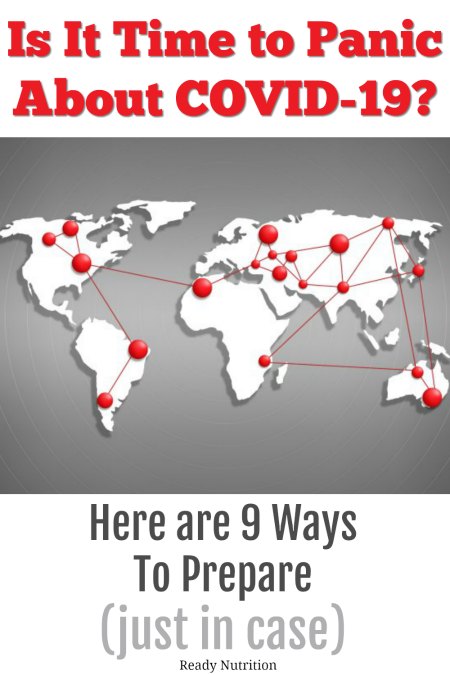By now, you have probably seen people walking in public areas with a mask on. Are they being too cautious?
It’s difficult not to panic in regards to COVID-19 given what is unfolding around us. More and more cases are occurring, stock markets are spiraling, the virus is moving out of Asia and into parts of Europe, health officials are still struggling with containment and proper procedures, medical equipment is scarce. And there is no cure. As guarded as we are, the signs do not look good.
While the WHO does not consider COVID-19 to be a pandemic yet, many communities are starting to prepare healthcare facilities and health professionals for more cases. If cases do not stop, home quarantines will become more frequent. And I don’t blame them! It’s better to be safe than sorry. This is a technique cities around the world are taking to help contain the spread of the new disease which includes Italy who saw a spike in cases over the weekend.
9 Ways to Prepare for COVID-19 in Your Community
It has been 100 years since the Spanish Flu caused a global pandemic and here we are sitting on the verge of a new one. While it is not time to panic, it is time to get prepared for COVID-19 coming to your community. Here are 9 ways to get ready!
First and foremost, mimic what the healthcare professionals are doing. If the CDC is getting ready and recommending healthcare professionals to have protective equipment or PPE, then you should too! At the very least, here are some items they are recommending to healthcare professionals:
Disposable gowns
gloves
NIOSH-certified disposable N95 respirator
eye protection
- Make preparations and discuss with family members the family’s pandemic plan.
- Prepare for home quarantine and have some entertainment available to family members: board games, books, art supplies, etc.
- For those with special needs, ensure that you have supplies ready for them (infants, elderly, handicapped, etc.).
- Prepare a sick room for the home to limit family member’s exposure to the virus. If someone in the house is infected, then the person needs to be segregated to a room of the house and that room needs to be sealed off from the rest of the home either using plastic sheeting or duct-taped closed with limited interaction from other family members.
- Seal off vents in a sick room to prevent the virus from spreading. Here is a video on how to do that.
- Consider all items coming in from the outside to be contaminated and should be washed with antibacterial soap or a chlorine mix before handling with bare hands. Therefore, any item you pick up after the emergency begins needs to be handled accordingly. Scan your home and delivery packages, and devices with a UV sanitizer (like this one) that utilizes UV light spectrum to eliminate 99% of viruses. The light has a range of 99% effectiveness which interferes and destroys nucleic acids of bacteria and other microbes. As well, it disturbs proteins in the microbes by killing certain amino acids.
- All common items in the house should be disinfected after use regardless if anyone is sick. The kitchen and bathrooms should be meticulously cleaned after use.
- If a family member dies in quarantine, seal off the room until professionals can deal with it. Don’t risk it. If you decide to take matters into your own hands, Wear long pants and long sleeves. Tuck your sleeves into your gloves. Dig your grave prior to moving the body. Spray the areas of the body you intend to touch with your bleach solution and wait 10 minutes before touching the body. Avoid touching the torso and head of the deceased person and only touch the disinfected extremities. Disinfect your clothing and shower after the operation is complete.
- Stay isolated until the quarantine is lifted.
What To Do If You Have to Leave Your Home
If you’re forced to exit your home, you’re going to want to be fully protected, and that includes covering your hands, eyes, nose, and mouth. In addition to the N-95 respirator masks, you may also consider upgrading to the more expensive N-100 respirators recommended by the World Health Organization. Read this article on their effectiveness and where to find them when the medical supply stores run out.
Or, go with a full facemask. Insofar as your preparedness efforts are concerned, you may also be able to kill two birds with one stone here and go with a full face mask that includes NBC (Nuclear, Biological, Chemical) protection like the US-made NATO SGE 400/3 Military Gas Mask.
What You Need to Know About Pandemics
If you plan on preparing for multiple waves of a pandemic virus, it is important to have everything in place before the virus spreads to your community. In The Prepper’s Blueprint, I explained how important it is to have a layered approach to your preparedness supplies. Don’t just prepare for a pandemic, but everything else that could happen as a result of that triggering event. It’s not just medical supplies you will need, but supplies to live long-term without having to venture outside and exposing yourself to a deadly pathogen. Gather items now (before the panic) is the absolute best approach to being prepared! As well, you are more level headed and less likely to forget an item.
When an outbreak occurs, those living in cities, and those living in close proximity to others will be more at risk. Statistics from previous pandemics indicate that 30–60 percent of the population will contract an illness. Any pregnant women, infants, elderly people, or those with chronic medical conditions are also at risk and could be the first of the population to contract the contagious illness. When the pandemic begins, many will remain in a state of denial about any approaching epidemics and not want to think of the long-lasting repercussions of such a disaster. Being prepared before the mass come out of their daze will ensure that you are better prepared before the hoards run to the store to stock up. Having first-hand knowledge of the government’s protocols before this type of emergency arises can help put you ahead of the game. Understanding that our lives will change drastically if the population is faced with a pandemic and being prepared for this can help you make better choices toward the well being of your family. Some changes could be:
- Challenges or shut downs of business commerce
- Breakdown of our basic infrastructure: communications, mass transportation, supply chains
- Payroll service interruptions
- Staffing shortages in hospitals and medical clinics
- Interruptions in public facilities – Schools, workplaces may close, and public gatherings such as sporting events or worship services may close temporarily.
- Government-mandated voluntary or involuntary home quarantine.
In The Prepper’s Blueprint, I have suggested these preps to purchase to prepare for pandemics:
One month supply of emergency foods that require no refrigeration.
Store 1 gallon of water per person per day, in clean plastic containers.
Plastic sheeting
Gallon-sized zip-loc bags
A portable toilet with disposable liners
Supply of nonprescription drugs and pain relievers
Cold medicines and decongestants
Stomach remedies
Duct tape
Anti-diarrheal medication
Vitamins that have immune-boosting enhancers
Electrolytes
Bleach or disinfectant
Soap
Tissues
Garbage bags to collect soiled clothing and bedding before they are washed.
A thermometer
Protective eye gear and/or face shield
Tychem protective suit and shoe covers
Disposable cleaning gloves (in quantity)
Hand wipes
Alcohol-based hand sanitizers or homemade hand sanitizer supplies
Protective clothing
Disposable aprons or smocks (at least 2 cases)
Duct tape for sealing off doorways and vents
Disposable nitrile gloves (2-3 boxes)
Garbage bags
N95 masks or N100 respirator masks for use when the sick person is coughing or sneezing (can be purchased at hardware stores and some drugstores)
It has been 100 years since the Spanish Flu caused a global pandemic and here we are sitting on the verge of a new one. While it is not time to panic, it is time to get prepared. The truth of the matter is no country is fully prepared and the responsibility rests with the citizens and how well they are prepared.

This article was originally published at Ready Nutrition™ on February 24th, 2020








Excellent article. But, you forgot one thing: the virus can also infect a human by an ear entry. Protect your ear’s too!